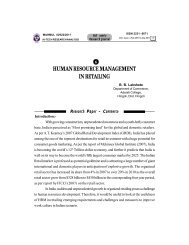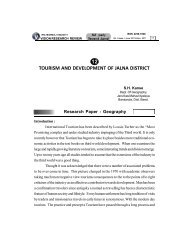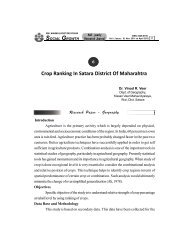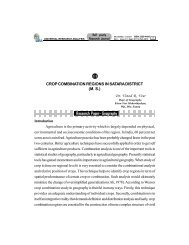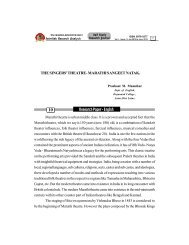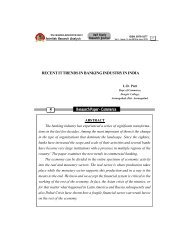A Geographical Study Of Food Grain Cropping Pattern
A Geographical Study Of Food Grain Cropping Pattern
A Geographical Study Of Food Grain Cropping Pattern
Create successful ePaper yourself
Turn your PDF publications into a flip-book with our unique Google optimized e-Paper software.
Explanation<br />
UNIVERSAL RESEARCH ANALYSIS<br />
Half yearly<br />
Research Journal<br />
RNI. MAHMUL 13/2/2010 ISSN 2229-4406<br />
Vol. I , Issue :I I I, Sept. 2011 to Feb. 2012<br />
<strong>Food</strong> grains play a major role in the cropping of land under tillage in Solapur<br />
district. For only, under food grains can they produce enough to sustain the dense population<br />
in the study region. Moreover, food grain crops are relatively less demanding and less<br />
exacting in their soil moisture requirements than fiber crops. High percentages under food<br />
grain are noted in the western part of the district. Overall, the cereals and pulses domi-<br />
nate the agriculture land-use crop of the region.<br />
1) Jowar<br />
Jowar is first in importance as a staple crop in Solapur district. Its botanical<br />
name is sorghum vulgare. Jowar is also known as great millet. Among all the food grains<br />
in the region, it is a staple food crop of the rural population. It is a first ranked crop.<br />
Jowar is a leading crop in the study region occupying about 60.45 percent (748200<br />
hectares) in 1980-81, but it was 51.04 percent (482400 hectares) of the total cultivated<br />
area in 2004-05. It decreased by 9.41 percent in the investigated period because non-food<br />
grains replaced the jowar area. The main improved varieties grown in the region are<br />
C5H5,CH5,M35-1 and local kharif Jowar.<br />
Environmental Requirements :-<br />
Jowar is purely a tropical crop. The crop thrives well under the condition of high<br />
temperature requiring mean temperature of over 27º c and moderate rainfall between<br />
350 mm to 900 mm. Jowar is grown on heavy and light alluvium to red ,medium black to<br />
deep black and even sandy soils. It is mostly cultivated in kharif as well as rabi season but<br />
in the study region, it is mainly cultivated in rabi season.<br />
Spatial Distribution :-<br />
Spatial distribution of jowar crop in the study region vary from tahsil to tahsil in<br />
the reference year 2004-05. The area under jowar crop was very high (74.94 percent)<br />
in Mangalwedha then followed by North Solapur(67.63 %), Sangola(63.68 %) and<br />
Mohol(60.71%). Below 30 percent, area under this crop is observed in Malshiras,<br />
Pandharpur and Karmala tahsils. The remaining tahasil has covered area between 30 to<br />
60 percent under this crop of the net sown area.<br />
6 3



